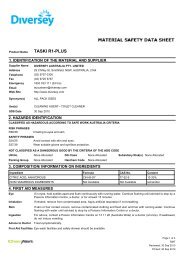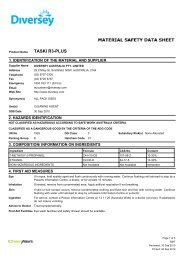MSDS - Taski R2L Plus 2010 - Melbourne Cleaning Supplies
MSDS - Taski R2L Plus 2010 - Melbourne Cleaning Supplies
MSDS - Taski R2L Plus 2010 - Melbourne Cleaning Supplies
You also want an ePaper? Increase the reach of your titles
YUMPU automatically turns print PDFs into web optimized ePapers that Google loves.
Product Name<br />
TASKI <strong>R2L</strong>-PLUS<br />
10. STABILITY AND REACTIVITY<br />
Chemical Stability Stable under recommended conditions of storage.<br />
Conditions to Avoid Avoid heat, sparks, open flames and other ignition sources.<br />
Material to Avoid Incompatible with oxidising agents (eg. hypochlorites), acids (eg. nitric acid), nitrites, heat and ignition<br />
sources.<br />
Hazardous<br />
Decomposition<br />
Products<br />
May evolve toxic gases (carbon/ nitrogen oxides, hydrocarbons) when heated to decomposition.<br />
Hazardous Reactions Polymerization will not occur.<br />
11. TOXICOLOGICAL INFORMATION<br />
Health Hazard<br />
Summary<br />
Use safe work practices to avoid eye or skin contact and inhalation. Ethanolamine is irritating to eyes, skin, and<br />
the respiratory tract. Over exposure may result in CNS depression and liver/kidney damage. Persons suffering<br />
from asthma, pre-existing skin disorders, or impaired liver, kidney, or pulmonary function may be more susceptible<br />
to the effects of exposure.<br />
Eye Contact may result in irritation, lacrimation, pain, redness and conjunctivitis. May result in burns with prolonged<br />
contact.<br />
Inhalation Over exposure may result in irritation of the nose and throat, coughing and headache. High level exposure may<br />
result in dizziness, nausea and drowsiness. Chronic exposure may result in kidney, liver and CNS damage.<br />
Skin Contact may result in drying and defatting of the skin, rash and dermatitis.<br />
Ingestion Ingestion may result in nausea, vomiting, abdominal pain, diarrhoea, dizziness and drowsiness.<br />
Toxicity Data ETHANOLAMINE (141-43-5)<br />
LD50 (Ingestion): 620 mg/kg (guinea pig)<br />
LD50 (Intramuscular): 1750 mg/kg (rat)<br />
LD50 (Intraperitoneal): 50 mg/kg (mouse)<br />
LD50 (Intravenous): 225 mg/kg (rat)<br />
LD50 (Skin): 1 mL/kg (rabbit)<br />
LD50 (Subcutaneous): 1500 mg/kg (rat)<br />
12. ECOLOGICAL INFORMATION<br />
Environment Limited ecotoxicity data was available for this product at the time this report was prepared. Ensure appropriate<br />
measures are taken to prevent this product from entering the environment.<br />
Ecotoxicity Not classified as dangerous to the aquatic environment.<br />
Persistence /<br />
Degradability<br />
Limited information was available at the time of this review.<br />
Mobility Limited information was available at the time of this review.<br />
13. DISPOSAL CONSIDERATIONS<br />
Waste Disposal For small quantities, add to a tray of sodium bisulphate. Neutralise and discharge to sewer with large excess of<br />
water. Contact the manufacturer for additional information if larger amounts are involved.<br />
Legislation Dispose of in accordance with relevant local legislation.<br />
14. TRANSPORT INFORMATION<br />
NOT CLASSIFIED AS A DANGEROUS GOOD BY THE CRITERIA OF THE ADG CODE<br />
Shipping Name<br />
UN No.<br />
Packing Group<br />
None Allocated<br />
15. REGULATORY INFORMATION<br />
None Allocated DG Class None Allocated Subsidiary Risk(s) None Allocated<br />
None Allocated Hazchem Code None Allocated<br />
Poison Schedule A poison schedule number has not been allocated to this product using the criteria in the Standard for the Uniform<br />
Scheduling of Drugs and Poisons (SUSDP).<br />
AICS All chemicals listed on the Australian Inventory of Chemical Substances (AICS).<br />
Page 3 of 5<br />
RMT<br />
Reviewed: 01 Oct <strong>2010</strong><br />
Printed: 01 Oct <strong>2010</strong>




